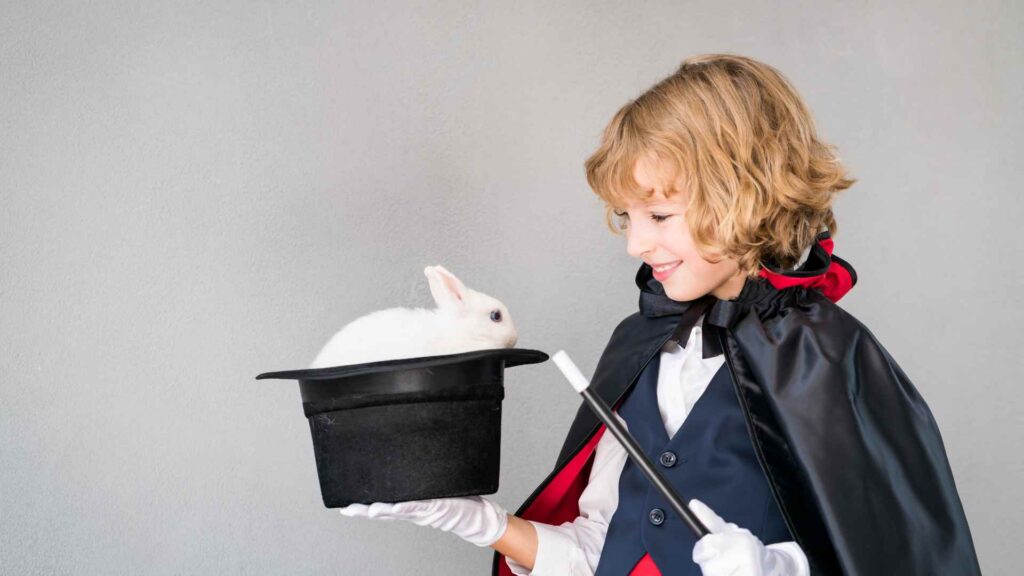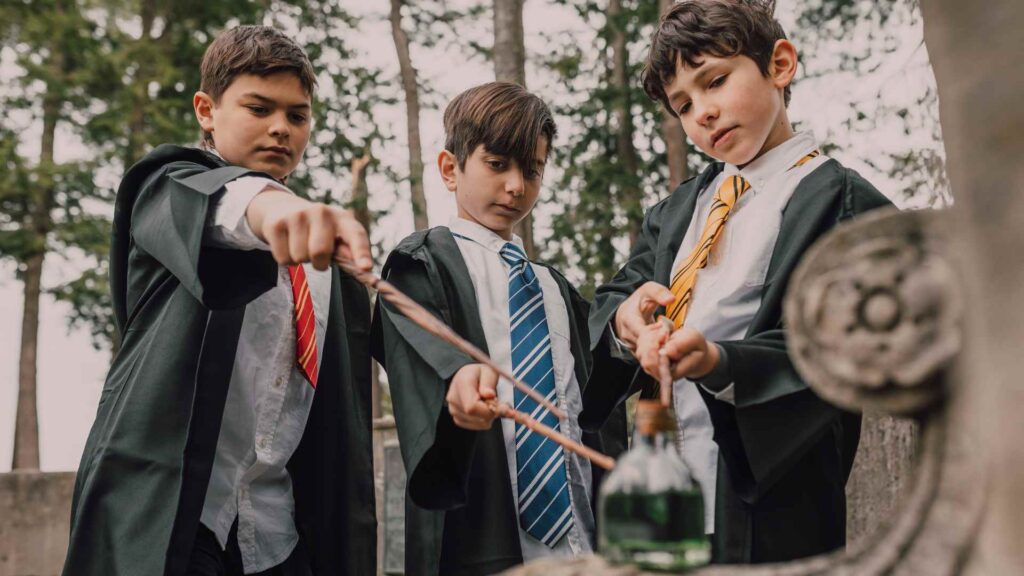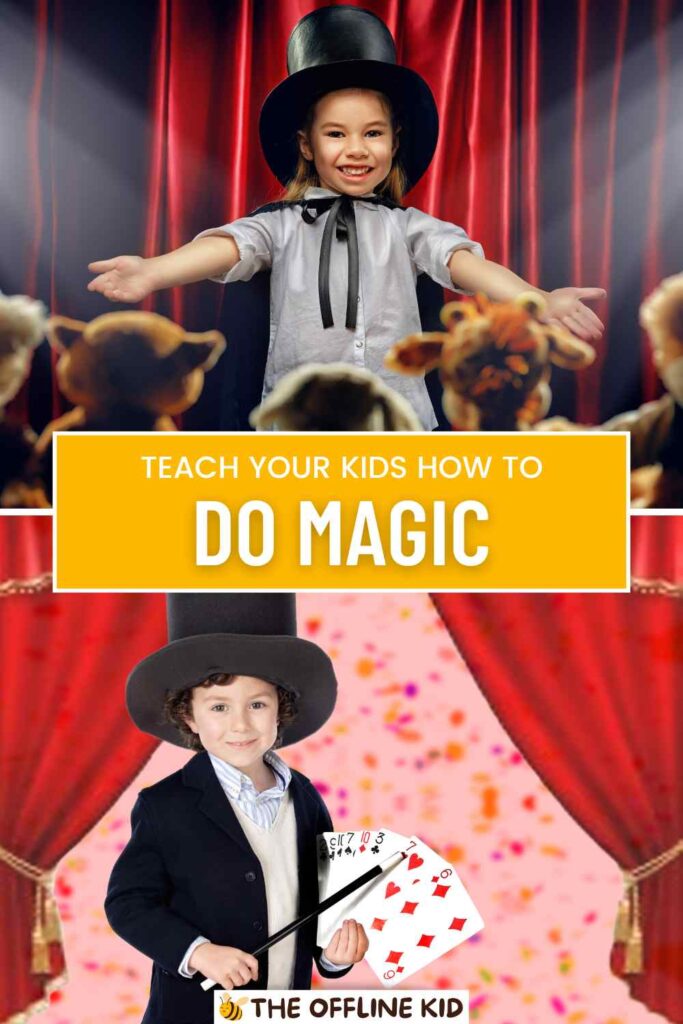Magic has a unique ability to captivate young minds and ignite their imaginations.
Whether your child’s dreams involve pulling rabbits from hats or simply learning exciting illusions, this comprehensive guide has everything you need.
Let’s explore how to bring the enchantment of magic into your child’s life.
The Magic of Childhood Imagination
Childhood is a time of wide-eyed wonder, boundless creativity, and endless possibility. Introducing magic to your child is an invitation to embrace those imaginative qualities wholeheartedly.
It’s more than just learning card tricks and illusions; it’s a way to encourage dreaming big, exploring the unknown, and believing in their ability to create delight for themselves and others.
With even the simplest illusions, children step into a world where everyday objects and ordinary moments can transform into something extraordinary.

One of the most beautiful aspects of magic is how it sparks curiosity. When children see a trick performed, their natural instincts drive them to ask questions like, “How did you do that?” or “Can I try that myself?”
This longing to discover the secrets behind magic can propel them to learn new skills, solve puzzles, and engage with their environment in innovative ways.
Furthermore, magic encourages a healthy sense of wonder. It reminds children that not everything in life is straightforward and obvious.
Through illusions, they can explore the intriguing side of reality, pondering possibilities that lie outside their usual understanding. By nurturing childhood imagination through magic, you empower your child to maintain that sense of awe and excitement for years to come.
Why Magic is Beneficial for Kids
Beyond its sheer entertainment value, magic offers numerous benefits that can have a profound impact on your child’s development. Consider how magic can:
- Boost Self-Confidence: Successfully performing a trick in front of family and friends helps children build trust in their abilities, making them feel more capable overall.
- Develop Fine Motor Skills: Performing illusions often involves sleight of hand, shuffling cards, and manipulating small props, all of which can refine children’s motor skills and hand-eye coordination.
- Foster Problem-Solving: Magic routines require kids to break down steps, memorize patterns, and practice repeatedly. This structured approach teaches children to analyze problems and think logically to achieve a desired outcome.
- Encourage Creativity: Inventing storylines, creating custom illusions, and adapting performance styles fosters imaginative thinking. Children soon discover that magic is as much about creativity as it is about technique.
- Promote Social Skills: Magic often involves interacting with an audience, encouraging children to communicate effectively and read people’s reactions. They learn to adjust their approach to keep viewers engaged.
When kids discover they have the power to perform illusions that spark amazement, they gain a sense of personal achievement and joy.
Introducing magic into their lives is not only fun, but it also lays the groundwork for valuable life skills that can continue to flourish. By supporting this curiosity and skill-building, you are helping your child develop the confidence, resilience, and social awareness needed to thrive in many areas of life.

Age-Appropriate Magic Tricks
Matching the right tricks to your child’s stage of development helps ensure they experience the thrill of magic without feeling overwhelmed.
For toddlers, keep it very simple: color-changing scarves or illusions with large, easily manipulated props. They may not fully grasp the technique but will love the surprise element.
For elementary-aged children, introduce slightly more challenging tricks, such as card tricks, coin vanishes, and basic rope illusions.
They’ll enjoy the feeling of mastery as they successfully pull off each routine. This age group is also more receptive to instructions, allowing them to truly understand the method behind the magic while honing their motor skills.
Preteens and teens can handle intricate illusions, including levitation tricks, elaborate card flourishes, and multi-step illusions that require a combination of skill and showmanship. This is also a good time to encourage them to develop their own unique performance style by adding storytelling elements or comedic flair.
Regardless of your child’s age, be sure to choose tricks that align with their interests. A trick involving a favorite toy or cartoon character will capture their attention more effectively.
By selecting illusions that are well-suited to your child’s developmental level and personal passions, you’ll help them thrive in their magical journey and sustain their interest over time.
Nurturing Curiosity and Confidence
Magic can be an incredible tool for nurturing a child’s curiosity and building their self-confidence.
By teaching them how to perform illusions, you invite them to question the status quo and become more observant. They learn to pay attention to details that others might miss, sharpening their mental focus and concentration.
Ideas for Encouraging Curiosity:
- Ask open-ended questions like, “What do you think is happening behind this trick?” or “How would you design a magic trick using your favorite book character?”
- Show them behind-the-scenes magic documentaries to spark their interest in the mechanics of illusions.
- Offer puzzle-like challenges—such as designing new ways to reveal a secret—so they can test their creativity and problem-solving skills.
Meanwhile, learning magic tricks fosters confidence because it helps children realize that they can create amazing results through practice and persistence.
Each successfully performed trick is a personal triumph that boosts self-esteem. Applause and expressions of surprise from family members or friends reinforce the child’s sense of capability.
As they refine their sleight of hand, they also learn the importance of perseverance. When a trick initially fails, they must adjust, try again, and keep practicing until they perfect their performance. This cycle of trial, error, and mastery translates into positive traits that benefit them in school, hobbies, and other endeavors.

Setting Up a Magical Environment
Creating the right environment for your child to explore magic can significantly enhance their learning experience.
A designated practice space—whether it’s a corner of their bedroom or a small stage in the living room—provides a sense of legitimacy. Have them decorate it with fun posters, twinkling lights, or whimsical curtains to make it feel like a true performance area.
Tips for Crafting a Magical Atmosphere:
- Keep a small table or desk stocked with magic props, like cards, scarves, wands, and coins.
- Encourage them to put on short shows for family and friends, fostering a spirit of performance and excitement.
- Use music or sound effects for added flair during practice sessions. This helps your child associate their magic practice with fun and creativity.
In addition to physical space, consider the atmosphere of support and enthusiasm you create. Praising your child’s effort instead of focusing solely on results ensures they remain motivated. Applauding their attempts—even if they stumble—fosters a positive learning environment.
Also, gently remind them that revealing the secret behind a trick to curious friends can sometimes lessen the mystique of magic.
Encourage them to maintain that sense of secrecy and showmanship, which makes the entire experience more enchanting. By balancing a creative workspace with emotional support, you’ll establish a foundation that allows your child’s confidence and magical skill set to flourish.
Essential Magic Supplies
To begin a magical journey, you don’t need a workshop full of elaborate gadgets. Start with a few essential supplies that will enable your child to explore a variety of illusions:
- Playing Cards: A quality deck of cards is indispensable. They’re used in countless magic routines, and children can learn everything from basic shuffles to advanced flourishes.
- Magic Wand: The classic magic wand remains a timeless accessory. It adds flair to performances and often functions as a secret tool for misdirection.
- Coins: Simple coin tricks can pack a punch and require minimal setup. They’re also perfect for teaching dexterity and sleight of hand.
- Ropes or Scarves: Brightly colored ropes, ribbons, or scarves are perfect for illusions that revolve around knots and transformations. They’re also visually appealing and easy for young magicians to handle.
- Props for Simple Vanishes: Items like small cups, thimbles, or silk hankies can work wonders for illusions involving disappearance.
While specialty props like trick decks or props with hidden compartments can be fun, it’s generally best to begin with everyday objects. This approach encourages children to rely on skill rather than gimmicks, building a stronger magical foundation. Over time, they can explore more specialized gadgets to expand their repertoire. Focusing on these basics allows children to explore a broad range of illusions, from close-up magic to showier stage tricks, helping them discover what resonates most with their creative spirits.
Teaching Methods and Techniques
As you introduce your child to the art of magic, the teaching approach can have a big impact on their learning and enjoyment. One highly effective method is the “I Do, We Do, You Do” technique:
- I Do: Demonstrate a new trick yourself. Perform it once at normal speed to capture your child’s attention, then do a slow-motion demonstration so they can see the key moves.
- We Do: Practice together step-by-step. Guide your child’s hands if necessary, and make sure they understand each motion and secret move involved.
- You Do: Encourage them to attempt the trick independently while you watch and offer constructive feedback.
In addition to guided practice, it can be helpful to use video tutorials and magic books. Not only do these resources give your child a chance to learn new moves, but they also expose them to a range of magic styles and presentation techniques. When children discover different magicians’ performances, they start to understand how to integrate humor, suspense, or drama into their own acts.
Finally, emphasize the notion of practice. Remind them that even famous magicians spend countless hours refining their craft. Learning to accept mistakes and continue practicing underscores the message that real magic lies in dedication, perseverance, and a passion for performance. By combining these teaching methods, you can set your child on a path to truly mastering the art of illusions.
Overcoming Challenges
Learning magic can be exhilarating, but it’s not without its hurdles. Common challenges include:
- Frustration with Practice: Children may become discouraged when they can’t master a trick immediately. Remind them that misdirection and sleight of hand demand time to refine.
- Stage Fright: Some kids love learning illusions but shy away from performing. Gently encourage them to start with small, intimate audiences—like family members—before moving on to friends or larger groups.
- Maintaining Secrecy: Children often feel the urge to blurt out how their trick works, especially when they see others’ amazed reactions. Stress that the mystery is part of the fun and that revealing the secret can sometimes diminish the trick’s impact.
- Comparing Themselves to Others: If a child sees a peer who is more advanced, they might feel inferior. Reinforce that everyone progresses at their own pace.
Strategies to Overcome These Obstacles:
- Celebrate small victories and improvements in technique.
- Offer positive, constructive critiques that focus on what they did well, and gently suggest changes where needed.
- Encourage them to record and review their performances to identify strengths and areas for improvement.
By recognizing the challenges and offering loving support, you can help your child keep the spark of magic burning bright. Whether they move at a rapid pace or need extra time to gain confidence, knowing they have a supportive audience will encourage them to stick with magic and continue developing their skills.
Fun Magic Activities & Ideas
Making magic an integral part of your child’s life doesn’t have to end with learning individual tricks. There are countless fun activities that reinforce their skills and keep them excited:
- Magic Show Night: Organize a special evening where your child performs a short routine. Invite friends or family, and encourage them to dress up in glamorous outfits for a genuine show atmosphere.
- Magic-Themed Party: For birthdays or holidays, decorate with playing cards, top hats, and sparkly backdrops. Let your child showcase their skills, and perhaps involve guests by teaching them a simple trick.
- Scripting and Storytelling: Encourage children to write their own scripts for illusions. When they blend a narrative with their trick, the performance feels more immersive and personal.
- DIY Prop Creation: Get crafty with your child. Let them paint their own magic wand or decorate a small box that doubles as a secret compartment. This hands-on approach teaches them the behind-the-scenes value of illusion-building.
- Magic Workshops: If available in your area, consider enrolling your child in a local or online workshop led by a professional magician. These structured sessions provide guided practice and group interactions that help your child enhance their skills.
Incorporating these activities will enrich your child’s magical journey, making it not just a hobby but a thriving creative outlet. The blend of performing, creating, and collaborating ensures that your child remains eager to try new illusions and share them in unique ways.
Sustaining Long-Term Interest in Magic
Introducing magic to your child is only the beginning. Sustaining their passion involves consistent encouragement, challenges that keep them engaged, and a path for continued growth.
One way to hold their interest is to set personal magic goals, such as learning a certain number of new tricks per month or planning a larger show for the end of the school year.
Advanced Learning Opportunities:
- As your child’s interest grows, explore magicians’ autobiographies or professional how-to guides. Reading about performers who have dedicated their lives to the craft can be truly inspiring.
- Encourage them to participate in magicians’ clubs—either in person or online. These gatherings often include mentorship from experienced performers, which can accelerate skill development.
- Suggest trying out digital tools like video editing or online streaming to create magic videos. This modern twist on magic encourages them to blend illusions with multimedia effects, further expanding their horizons.
Lastly, remind them that magic is an ever-evolving art form. New illusions emerge, innovative techniques get discovered, and performance styles shift with time.
By keeping an open mind and continuing to learn, your child can find fresh inspiration at every turn, ensuring magic remains a meaningful and rewarding hobby.
Providing steady support and new challenges ensures they feel excited about expanding their repertoire, whether it’s for fun, personal growth, or even future professional aspirations.


